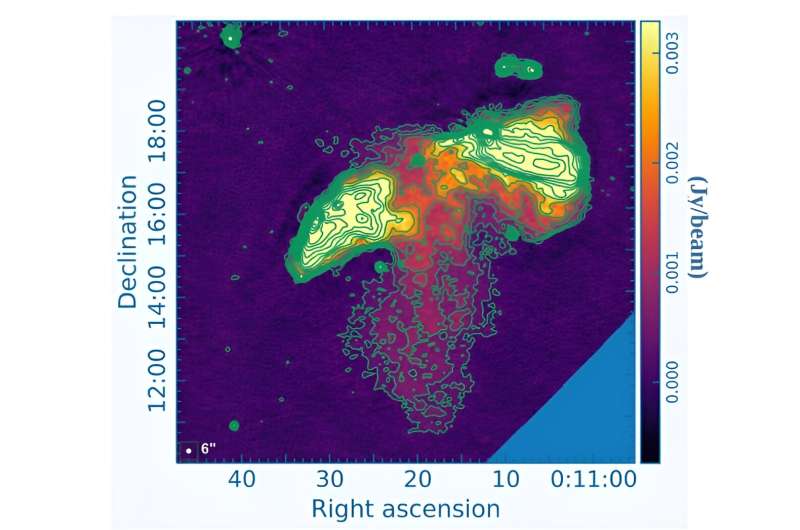July 1, 2024 report
This article has been reviewed according to Science X's editorial process and policies. Editors have highlighted the following attributes while ensuring the content's credibility:
fact-checked
preprint
trusted source
proofread
Astronomers discover a peculiar radio galaxy

Using the LOw-Frequency ARray (LOFAR), astronomers have discovered a new radio galaxy. The newfound galaxy, designated J0011+3217, showcases peculiar features, including a one-sided secondary lobe. The finding was reported in a research paper published June 21 on the pre-print server arXiv.
Radio galaxies emit huge amounts of radio waves from their central cores. Black holes at the centers of these galaxies accrete gas and dust, generating high-energy jets visible in radio wavelengths, which accelerate electrically charged particles to high velocities.
During its active stage (lasting up to 100 million years) a typical radio galaxy is observed to contain such features as core, lobes, jets and hotspots. However, after this stage passes, these signatures of activity generally disappear as the source's active galactic nucleus (AGN) switches off and the galaxy enters the so-called remnant or dying phase.
Now, a team of astronomers led by Shobha Kumar of the Midnapore City College in India, reports the detection of such a radio galaxy with lobes.
"From the LOFAR Two-meter Sky Survey second data release (LoTSS DR2) at 144 MHz, we identified a peculiar radio galaxy, J0011+3217," the researchers wrote in the study.
According to the paper, J0011+3217 is a giant radio galaxy with a one-sided secondary lobe and misaligned giant primary lobes. It appears that the newfound galaxy is associated with the galaxy cluster Abell 7.
LOFAR observations show that the secondary lobe has a linear size of approximately 2.77 million light years, which is about 85% of the primary lobe. Such one-sided secondary lobes are extremely rare, as only a handful of them have previously been discovered in some X-shaped radio galaxies.
The astronomers underline the large size of the one-sized secondary lobe in J0011+3217, as such features are usually more than four-times smaller than the primary lobes. Thus, a giant one-sized secondary lobe like the one in J0011+3217 has never been observed in any other X-shaped radio galaxies.
The study also found that J0011+3217 possesses minor distortions or off-axis diversions. Such bending in the jet is more common for wide-angle tails (WATs). The so-called WATs are powerful, bent radio sources typically associated with the dominant galaxy in a cluster or group.
Summing up the results, the authors of the paper underline the need for further studies of J0011+3217 in order to fully understand its peculiarities.
"To measure the detailed parameters and study the conditions under which this peculiar radio galaxy J0011+3217 forms, further studies, including simulations and optical follow-up observations, will be encouraged," the researchers conclude.
More information: Shobha Kumari et al, J0011+3217: A peculiar radio galaxy with one-sided secondary lobe and misaligned giant primary lobes, arXiv (2024). DOI: 10.48550/arxiv.2406.14889
Journal information: arXiv
© 2024 Science X Network





















